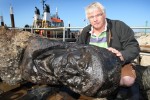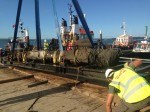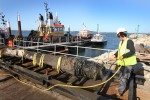 Bournemouth University marine archaeologists have raised the elaborately carved rudder of a 17th century wreck from the seabed of Swash Channel outside of Poole Harbour off the southwest coast of England. The rudder is eight a half meters (27.9 feet) long, weighs three and a half tons and a has a man’s head sporting a dashing moustache carved out of one end of the beam. The pupils are concave; historians believe they may have once held precious or semi-precious stones, a testament to how extravagantly appointed this ship was.
Bournemouth University marine archaeologists have raised the elaborately carved rudder of a 17th century wreck from the seabed of Swash Channel outside of Poole Harbour off the southwest coast of England. The rudder is eight a half meters (27.9 feet) long, weighs three and a half tons and a has a man’s head sporting a dashing moustache carved out of one end of the beam. The pupils are concave; historians believe they may have once held precious or semi-precious stones, a testament to how extravagantly appointed this ship was.
The Swash Channel Wreck was discovered in March of 1990 when a Dutch dredging ship struck an obstacle. They pulled up timbers and a cannon, but there was no further investigation at that time. In 2004 the Poole Harbour Commissioners and Poole Borough Council site commissioned Wessex Archaeology to survey the site and English Heritage contracted further exploration in 2005. Wessex Archaeology found a structure 65 feet long that included some the upper deck like the forecastle with its galley and gunports. This is almost unheard of in shipwrecks because the top parts are usually destroyed in the wrecking.
 Bournemouth University was enlisted in 2006 by English Heritage to monitor the site. They discovered that the wreck site, which was actually twice the size the original survey had found it to be, was in danger from sediment loss in the active shipping lane. As the sand levels lowered, artifacts were being exposed to corrosion, bacteria and shipworm and rapidly degrading. Raising the shipwreck like was done with the Mary Rose would be prohibitively expensive, so the university kept monitoring the site and experimented with methods of in situ conservation.
Bournemouth University was enlisted in 2006 by English Heritage to monitor the site. They discovered that the wreck site, which was actually twice the size the original survey had found it to be, was in danger from sediment loss in the active shipping lane. As the sand levels lowered, artifacts were being exposed to corrosion, bacteria and shipworm and rapidly degrading. Raising the shipwreck like was done with the Mary Rose would be prohibitively expensive, so the university kept monitoring the site and experimented with methods of in situ conservation.
In 2010, Heritage Lottery Fund gave the university a £141,200 ($220,000) grant for the excavation, documentation and, where possible, recovery of the ship artifacts. For the next three years, Swash Channel saw the largest underwater excavation in the UK since the raising of the Mary Rose in 1982. More than 1200 objects have been lifted from the site, among them timbers, ropes and pulley blocks from the rigging, cannon, cannon balls, barrels that once held salt pork for the crew, lanterns, gun carriages, navigational equipment and personal items like leather shoes, wooden bowls and tankards. No cargo has been found, interestingly enough, suggesting that either it and its containers have been destroyed or that there was a salvage operation after the ship sank.
 No identifying information was discovered so we don’t know what ship this was or even where it came from, but archaeologists believe it was probably a Dutch trading ship carrying luxury goods like high-end fabrics from Europe to Asia and carrying spices on the way back. Dendrochronological analysis found the timbers came from the German-Dutch border and were felled in 1628. Further research suggests that the ship was built in Holland in 1628 or 1629 and that it sank relatively shortly thereafter, sometime between 1630 and 1645. The rudder may provide more information about the ship and its origin.
No identifying information was discovered so we don’t know what ship this was or even where it came from, but archaeologists believe it was probably a Dutch trading ship carrying luxury goods like high-end fabrics from Europe to Asia and carrying spices on the way back. Dendrochronological analysis found the timbers came from the German-Dutch border and were felled in 1628. Further research suggests that the ship was built in Holland in 1628 or 1629 and that it sank relatively shortly thereafter, sometime between 1630 and 1645. The rudder may provide more information about the ship and its origin.
The exceptional quality of the carving you see on the rudder was widespread throughout the ship, unmistakable symbols of wealth. Done in early Baroque style, the carvings include mermen on the bow and two cherubs on the gunports. The carved pieces were first photographed by divers in 2005. A bowcastle merman was raised in 2011 and 40 feet of the bow were raised in 2012. The rudder is the last and largest piece to be raised.
 Divers spent a week digging the partially buried rudder out of the sand and placing it in a steel frame so it could be raised with a minimum of stress on the wood. On Monday, August 19th, the rudder was lifted out of its watery home of 400 years. It can’t be allowed to dry out or it will shrink, warp and degrade, so it was constantly sprayed with water before being transferred to the York Archaeological Trust. There it will be treated with polyethylene glycol (PEG) for two years until all the water is replaced with the waxy substance that never evaporates. That will keep the wood supple and allow the rudder to go on permanent display at the Poole Museum. Some of the smaller artifacts are scheduled to go on display next year; the rudder and the bowcastle will join them in 2015 or 2016.
Divers spent a week digging the partially buried rudder out of the sand and placing it in a steel frame so it could be raised with a minimum of stress on the wood. On Monday, August 19th, the rudder was lifted out of its watery home of 400 years. It can’t be allowed to dry out or it will shrink, warp and degrade, so it was constantly sprayed with water before being transferred to the York Archaeological Trust. There it will be treated with polyethylene glycol (PEG) for two years until all the water is replaced with the waxy substance that never evaporates. That will keep the wood supple and allow the rudder to go on permanent display at the Poole Museum. Some of the smaller artifacts are scheduled to go on display next year; the rudder and the bowcastle will join them in 2015 or 2016.
The vast majority of the wreck — 96% of it — remains on the seabed. Only the bulky pieces that were sticking up too far to be covered with sand without creating a dangerous bump have been removed. The rest has been covered with sand and sealed to keep it safe from erosion and would-be looters. The site will continue to be monitored to ensure the sands don’t shift again and expose this unique object to decay.